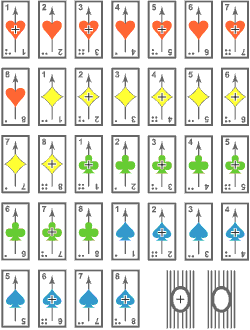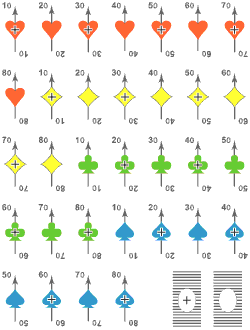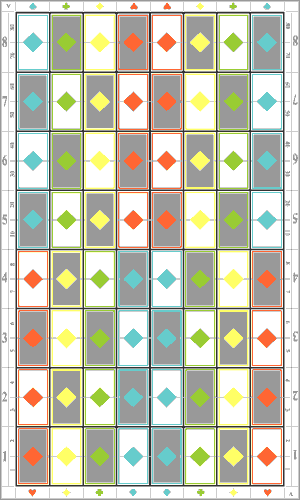|
First card pack.

Second pack of cards.

Designations of playing cards of
different packs depending on design can be executed by various images.
But in any case the first and second packs have attributes of difference
on faces of sheets and different pictures on backs of playing cards.
Board ŤAť for card games.

Complete set of game construction can contain three chess boards
and three packs of playing cards, and also deck of jokers.
About constructive features of two complementary chess boards and third pack
of playing cards with jokers it is possible to learn in the
full
version of game design. If
playing cards in games or patience puzzles have dispositions across
rectangular sectors then it is possible to use additional chess boards
which are shown on corresponding page of this website. |
Distributions of playing cards.
Colors and digits in 1st pack.
Two proportional groups.
1) 1R 1G 2Y 2B 3R 3G 4Y 4B 5R 5G 6Y 6B 7R 7G 8Y 8B.
2) 1B 1Y 2G 2R 3B 3Y 4G 4R 5B 5Y 6G 6R 7B 7Y 8G 8R.
Four proportional groups.
1) 1B 2G 3Y 4R 5B 6G 7Y 8R.
2) 1Y 2R 3B 4G 5Y 6R 7B 8G.
3) 1R 2Y 3G 4B 5R 6Y 7G 8B.
4) 1G 2B 3R 4Y 5G 6B 7R 8Y.
Colors and digits in 2nd pack.
Two proportional groups.
1) 1R 1Y 2G 2B 3R 3Y 4G 4B 5R 5Y 6G 6B 7R 7Y 8G 8B.
2) 1B 1G 2Y 2R 3B 3G 4Y 4R 5B 5G 6Y 6R 7B 7G 8Y 8R.
Description of playing cards in the basic version of game construction..
Or look brief description of basic game version.
The offered game design or construction differs from traditional
playing cards which are well-known in poker or bridge gaming. But in
essence it is classical playing cards which have four colors and
mathematical number of meanings, or otherwise to tell four suits and
digits of numerical values.
Colors are put on playing cards by different paints in drawings of
traditional suits. Red as hearts, yellow as diamonds, green as clubs,
blue as spades. Digital meanings or otherwise to tell numerical values
on playing cards are put by numbers or figures from 1 to 8. Colors and
meanings on cards are said: 1R - one red, 2Y - two yellow, and so on.
The basic version of game construction contains two packs which include
32 playing cards everyone and have distinctive attributes or signs. Two
players or gamers can play everyone with own pack, and can distinguish
playing cards owing to distinctive signs.
The first card pack has dark frameworks on faces of sheets and dark
circles on the backs. The second card pack has no dark frameworks and circles.
Besides playing cards of two packs differ by means of focusing arrows
which are available on faces of sheets. Namely focusing arrows allow to
direct playing cards aside opponents at dispositions on game boards and
arrangements of players opposite each other. As a result players can
distinguish own card sheets during board games.
Digital meanings of playing cards in the second pack have added or
attached zeroes which provide difference and identity of numerical
values in two packs. For example, 1R one red in the first and 10R ten
red in the second pack depending on chosen variants of game rules can be
perceived as equal or as having tenfold digital difference of numerical values.
Especial constructive feature of the present board game is distribution
of each pack on proportional playing groups in which colors and digital
meanings have mathematical proportionality, that is designated on faces
and backs of card sheets by presence and absence of daggers. Each pack
includes two proportional groups, namely 16 playing cards in everyone.
Two players according to mathematical proportions of distribution can
choose or two equivalent packs, or two proportional groups of playing
cards of structure of any one pack, and thus equal chances of a prize
will be obey.
1, 2, 3 and 4 points on sheets of playing cards designate distribution
of one pack to four proportional gaming groups which can be chosen in
that case when four players participate in games, that also provides
equal chances of a prize.
Namely different quantities of playing cards can be chosen for games or
puzzles, but in any case players can have proportional ratios of suits
and digits if observance of equal chances of a prize is necessary as in
a chess gaming. And also if playing cards according to rules of board
games are open and similar to chessmen.
Squares or sectors of game board in the basic version of complete set
have rectangular geometrical forms which corresponds to shapes of
playing cards. Rectangular sectors or squares of game board have color
suits and digital meanings similar to playing cards of two packs. Colors
correspond with verticals, and digital meanings with horizontal numbers
of squares. Colors are put on rectangular sectors by different paints,
and digital meanings are specified on edges of game board as numerical
designations or otherwise to tell mathematical notation.
Numbers of mathematical notation are parallel and perpendicular for
geometrical forms of game board, that shows digital meanings which can
be used at playing interactions lengthwise or crosswise of rectangular
sectors. Namely which can be used in different variants of games or
puzzles in which playing cards can be disposed lengthwise or crosswise
rectangular sectors on the board.
The perpendicular numerical notation considers zeroes which are attached
to digital meanings of playing cards in one of packs.
Rectangular sectors alternate on light and dark in staggered rows as on
a chess-board, that allows to trace diagonals and is necessary for some
variants of card games and puzzles. Dark sectors are designated by dark
rectangles which geometrical sizes are less than linear marking of the
board, that is the constructive decision necessary that players or
gamers could see color values of suits which are specified not only in
the centers as geometrical rhombuses, but also along perimeters of
rectangular sectors.
More thin linear marking divides and halves rectangular sectors, that
allows to have playing cards lengthwise or crosswise of game board.
In total constructive design of game board is adapted for arrangements
of playing cards and carrying out of every possible variants of games
and puzzles within linear marking. Or otherwise to tell within linear
geometrical matrix which cellular structure is similar to the device of
chess board, but is coordinated with colors and numerical digital values
of two playing card packs.
The basic rule or main idea of game consists that players distribute
playing cards according to distinctive designations of packs or
proportional groups. After that players put own packs or proportional
groups in initial gaming positions which are resulted in PDF files, and
then manipulate playing cards on rectangular sectors of chess board
according to rules of various games.
Thus players have equal chances of a prize owing to proportional
distribution of colors and digital values. And also players can have
full information about playing cards of opponent if initial gaming
positions are open according to game rules, that is similar as a chess.
Or constructive design allows to play cards as board games in which
information can be hidden, also distribution of suits and digital values
between players can be casual and disproportional, that is similar as
bridge or poker.
As well as traditional playing cards which are known from time
immemorial, this offered "open constructive design" allows to carry out
various games and patience puzzles which can have own names.
|